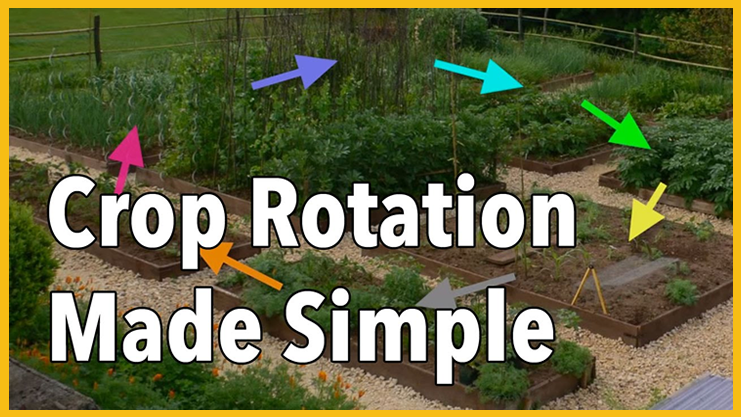Planning a Vegetable Garden Layout – Crop Rotation

By Valorie Shatynski
Late winter and early spring tugs at our gardening urges to plan this year’s vegetable and herb gardens.
This is the ideal time to put some forethought into the layout of your production garden. The priority is to make a list of which veggies will be eaten and enjoyed most by you and those in your household. Then, before you start seedlings or shop for starts at the nursery, make a simple drawing of the area you will use for this purpose. A list of the most common vegetables by “family” is provided at the end of this article. Simply stated, plant “Families” are those having similar flowering and fruiting characteristics. For example, the Goosefoot (Chenopodiaceae) family includes beets, spinach and Swiss chard. Where plants of different families are placed in your layout annually can make a huge difference in health of your plants and their production.
The first consideration is to recall the location of specific vegetables and fruits from previous years. It is important to move plants from the same family to a different location after two to three years. This is called crop rotation, and will allow recovery of the soil nutrients and reduce the diseases and pests to which each family is susceptible. If your garden is small, the best protection is to plant diversely (using mixed plant families) in the plot. This is because root systems extend and often intertwine, thereby rotation in a small area will not benefit by rotation.
Research has shown several problems which result from planting the same vegetable family in the same location year after year. One issue is depletion in the soil of the nutrients these “families” consume to produce vigorous plants and robust vegetables and fruit. Over time, this poor soil condition can be compounded by the buildup of diseases and pests in the soil that specifically impact each vegetable family. The end result is ever-decreasing plant health and production of quality produce.
Crop rotation in larger gardens is particularly important for plants in the Solanaceae (nightshade) family, although nearly all of them, including herbs, benefit from rotation. The most common garden vegetables/fruits in this family are tomatoes, eggplants, potatoes, bell peppers, hot (chili) peppers, tomatillos, and blueberries. In smaller gardens, the idea is to avoid planting a nightshade plant in the same spot every year.
Examples of diseases (fungi) which can accumulate in soils of the nightshade family are Verticillium wilt (V), and Late blight. Fusarium wilt (F) only impacts tomatoes. Disease-resistant varieties of these vegetables (especially tomatoes) have been developed, so look on plant start and seed-packet labels for coding by V, F, or VF. These fungi can overwinter in the plants and in the soil. The following links provide information regarding Verticillium and Fusarium wilts, and Late blight:
Verticillium:
https://ipm.ucanr.edu/agriculture/tomato/verticillium-wilt
https://ipm.ucanr.edu/PMG/GARDEN/PLANTS/DISEASES/vertwilt.html#
Fusarium:
https://ipm.ucanr.edu/agriculture/tomato/fusarium-wilt/
Late blight:
https://ipm.ucanr.edu/agriculture/tomato/late-blight
The following list provides the most common vegetables by family:
- Cole Crops (Brassicas): Arugula, Asian greens, Broccoli, Brussels sprouts, Cabbage, Cauliflower, Chinese cabbage, Daikon radishes, Kale, Kohlrabi, Mustard greens, Radishes, Turnips/Turnip greens
- Goosefoot (Chenopodiaceae): Beets, Spinach, Swiss chard
- Grasses (Poaceae): Corn (sweet, field, popcorn), Grains
- Legumes (Fabaceae): Beans (all), Peanuts, Peas (all)
- Lettuce (Compositae): Artichoke, Endive, Escarole, Lettuce, Sunflower
- Melon/Squash (Cucurbitaceae): Cantaloupes, Cucumbers, Gourds, Melons, Pumpkins, Summer squash, Watermelon, Winter squash, Zucchini
- Morning Glory (Convolvulaceae): Sweet potato
- Nightshade (Solanaceae): Eggplant, Peppers, Potatoes, Tomatillo, Tomatoes
- Onion (Amaryllidaceae): Chives, Garlic, Leeks, Onions
- Parsley (Umbelliferae): Carrot, Celery, Cilantro, Dill, Fennel, Parsley, Parsnip
An excellent resource for vegetable gardening is Publication 8059 prepared by the UCANR:
https://anrcatalog.ucanr.edu/Details.aspx?itemNo=8059
Please visit the San Diego County Master Gardeners website for more vegetable gardening resources at the following link:
https://www.mastergardenersd.org/beginning-vegetable-gardening/
Shatynski has been a Master Gardener since 2016.

